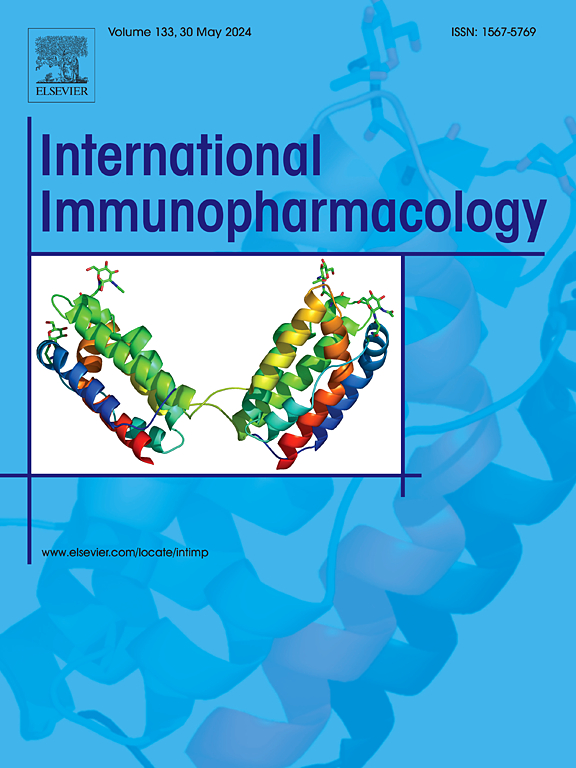空气污染物PM2.5通过NF-κB/ nlrp3诱导的焦亡加重气道炎症,而TLR4抑制剂TAK242部分抑制了这一作用
IF 4.7
2区 医学
Q2 IMMUNOLOGY
引用次数: 0
摘要
环境细颗粒物(PM2.5)被认为与哮喘的严重程度密切相关。然而,还需要研究这些发现的潜在机制。我们的研究试图通过体内和体外实验来证实NF-κB/NLRP3焦亡在哮喘加重中的作用。我们还通过RNA-Seq分析了差异表达基因,以研究潜在的调控机制。方法采用体内外实验研究PM2.5对小鼠哮喘模型和人支气管上皮细胞系Beas-2b的影响。用OVA致敏BALB/c雌性小鼠,建立小鼠哮喘模型。采用HE染色和EMAK系统评估小鼠肺部气道炎症和高反应性。我们还测量了IL-4、IL-5、IL-13和ova特异性IgE水平,以评估PM2.5对正常和ova诱导的哮喘小鼠的炎症作用。Western blotting和免疫组化分析NF-κB和焦亡蛋白的表达。用PM2.5处理人支气管上皮细胞Beas-2b,测定其焦亡程度。采用RNA测序(RNA- seq)技术鉴定差异表达基因并研究其潜在的调控机制。结果PM2.5暴露可显著提高哮喘小鼠模型的HE染色评分。暴露于pm2.5的哮喘组中,与气道反应性增强相关的乙酰胆碱水平低于对照组。与哮喘组相比,BALF组IL-1β和IL-18水平明显升高。与哮喘组比较,PM2.5组小鼠肺组织中NLRP3、Caspase-1、GSDMD-N、cleaved Caspase-1p10、IL-1β、p-NF-κBp65/NF-κBp65蛋白表达水平显著高于哮喘组。PM2.5在体外通过NF-κB/NLRP3通路引起Beas-2B人支气管上皮细胞焦亡和炎症。TLR4抑制剂TAK242可以部分阻断这种作用。结论在ova诱导的哮喘小鼠模型中,PM2.5激活NF-κB/NLRP3通路,诱导肺焦亡,从而加重气道炎症和高反应性。它可能通过TLR4/MyD88通路激活NF-κB信号级联,上调焦亡通路关键蛋白,诱导呼吸道上皮Beas-2b细胞焦亡和炎症,加重哮喘。本文章由计算机程序翻译,如有差异,请以英文原文为准。
The air pollutant PM2.5 aggravates airway inflammation via NF-κB/NLRP3-induced pyroptosis: partially inhibited by the TLR4 inhibitor TAK242
Background
Ambient fine particulate matter (PM2.5) is believed to be closely connected to asthma severity. However, studies are needed to investigate the underlying mechanism of these findings. Our study attempted to confirm the role of NF-κB/NLRP3 pyroptosis in asthma exacerbation through in vivo and in vitro tests. We also analyzed the differentially expressed genes via RNA-Seq to investigate potential regulatory mechanisms.
Methods
We undertook in vivo and in vitro research to investigate the effects of PM2.5 on a mouse asthma model and the human bronchial epithelial cell line Beas-2b. Female BALB/c mice were sensitized with OVA to create a murine asthma model. HE staining and the EMAK system were used to assess airway inflammation and hyperresponsiveness in mouse lungs. We also measured IL-4, IL-5, IL-13, and OVA-specific IgE levels to assess the inflammatory effects of PM2.5 on both normal and OVA-induced asthmatic mice. Western blotting and immunohistochemistry were used to analyze the expression of major NF-κB and pyroptosis proteins. Human bronchial epithelial Beas-2b cells were treated with PM2.5, and the degree of pyroptosis was determined. RNA sequencing (RNA-Seq) was employed to identify differentially expressed genes and investigate potential regulatory mechanisms.
Results
In vivo exposure to PM2.5 significantly increased HE staining scores in a mouse model of asthma. The levels of acetylcholine associated with enhanced airway responsiveness were lower in the PM2.5-exposed asthmatic group than in the control group. Compared with the asthmatic group, the BALF group presented considerably greater levels of IL-1β and IL-18. Compared with those in the asthmatic group, the protein expression levels of NLRP3, Caspase-1, GSDMD-N, cleaved Caspase-1p10, IL-1β, and p-NF-κBp65/NF-κBp65 in the lung tissues of the mice in the PM2.5 group were significantly greater than those in the asthmatic group. In vitro, PM2.5 causes pyroptosis and inflammation in Beas-2B human bronchial epithelial cells via the NF-κB/NLRP3 pathway. The TLR4 inhibitor TAK242 can partially block this effect.
Conclusion
In the OVA-induced asthma mouse model, PM2.5 activates the NF-κB/NLRP3 pathway and induces pyroptosis, thereby exacerbating airway inflammation and hyperreactivity. It may activate the NF-κB signalling cascade through the TLR4/MyD88 pathway, upregulate critical proteins in the pyroptosis pathway, and induce pyroptosis and inflammation in respiratory epithelial Beas-2b cells, exacerbating asthma.
求助全文
通过发布文献求助,成功后即可免费获取论文全文。
去求助
来源期刊
CiteScore
8.40
自引率
3.60%
发文量
935
审稿时长
53 days
期刊介绍:
International Immunopharmacology is the primary vehicle for the publication of original research papers pertinent to the overlapping areas of immunology, pharmacology, cytokine biology, immunotherapy, immunopathology and immunotoxicology. Review articles that encompass these subjects are also welcome.
The subject material appropriate for submission includes:
• Clinical studies employing immunotherapy of any type including the use of: bacterial and chemical agents; thymic hormones, interferon, lymphokines, etc., in transplantation and diseases such as cancer, immunodeficiency, chronic infection and allergic, inflammatory or autoimmune disorders.
• Studies on the mechanisms of action of these agents for specific parameters of immune competence as well as the overall clinical state.
• Pre-clinical animal studies and in vitro studies on mechanisms of action with immunopotentiators, immunomodulators, immunoadjuvants and other pharmacological agents active on cells participating in immune or allergic responses.
• Pharmacological compounds, microbial products and toxicological agents that affect the lymphoid system, and their mechanisms of action.
• Agents that activate genes or modify transcription and translation within the immune response.
• Substances activated, generated, or released through immunologic or related pathways that are pharmacologically active.
• Production, function and regulation of cytokines and their receptors.
• Classical pharmacological studies on the effects of chemokines and bioactive factors released during immunological reactions.

 求助内容:
求助内容: 应助结果提醒方式:
应助结果提醒方式:


